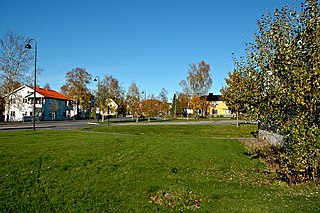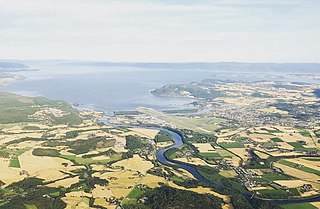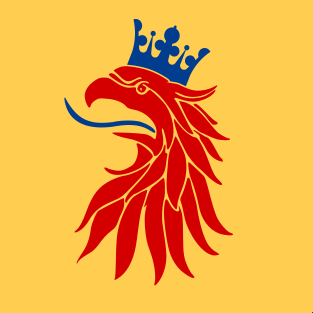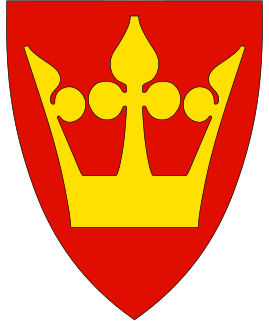
The flag of Denmark is red with a white Scandinavian cross that extends to the edges of the flag; the vertical part of the cross is shifted to the hoist side.

Dalarna County is a county or län in middle Sweden (Svealand). It borders the counties of Uppsala, Jämtland, Gävleborg, Västmanland, Örebro and Värmland. It is also bordered by the Norwegian counties of Hedmark and Trøndelag in the west. Its former name was Kopparberg County until it was changed to the name of the provincial region on 1 January 1997.

Aust-Agder was a county (fylke) in Norway until 1 January 2020, when it was merged with Vest-Agder to form Agder county. In 2002, there were 102,945 inhabitants, which was 2.2% of Norway's population. Its area was 9,212 square kilometres (3,557 sq mi). The county's administrative center was the town of Arendal.

Hordaland was a county in Norway, bordering Sogn og Fjordane, Buskerud, Telemark, and Rogaland counties. Hordaland was the third largest county after Akershus and Oslo by population. The county government was the Hordaland County Municipality which is located in Bergen. Before 1972, the city of Bergen was its own separate county apart from Hordaland. On 1 January 2020, the county was merged with neighbouring Sogn og Fjordane county to form the new Vestland county.

Spydeberg was a municipality in former Østfold county, Norway, until December 31. 2019. At January 1. 2020 it became a part of the new and greater municipality named "Indre Østfold Kommune" after the region, together with Askim and Trøgstad and Eidsberg and Hobøl kommuner (Municipalities).

Aurskog-Høland is a municipality in Akershus in Viken county, Norway. It is part of the Romerike traditional region. The administrative centre of the municipality is the village of Bjørkelangen. The municipality of Rømskog, in Østfold county was merged into Aurskog-Høland on January 1, 2020.

Sørum was a municipality in Akershus county, Norway. It is part of the traditional region of Romerike. The administrative centre of the municipality was the village of Sørumsand. Sørum was established as a municipality on 1 January 1838. The municipality of Blaker was merged with Sørum on 1 January 1962.

Stokke is a town in Sandefjord municipality in Vestfold County, Norway. It lies in-between Sandefjord and Tønsberg, two of Vestfold's largest cities. It was a municipality from 1838 to 2016. The administrative centre of the municipality was the village of Stokke, while minor villages were Vear, Melsomvik, Storevar, and Valberg.

Lardal is a former municipality in Vestfold county, Norway. The administrative centre of the municipality was the village of Svarstad. The parish of Laurdal was established as a municipality on 1 January 1838. The municipality was divided into the parishes of Svarstad, Styrvoll, and Hem.

Stjørdal or Skierde (Southern Sami) is a municipality in Trøndelag county, Norway. It is part of the Stjørdalen region. The administrative centre of the municipality is the town of Stjørdal, also called Stjørdalshalsen. Some of the villages in the municipality include Elvran, Flornes, Hegra, Hell, Kvithammer, Prestmoen, Skatval, Skjelstadmarka, Sona, and Værnes.

Hamarøy is a municipality in Nordland county, Norway. It is part of the traditional district of Salten. The administrative centre of the municipality is the village of Oppeid. Other villages include Drag, Innhavet, Karlsøy, Korsnes, Presteid, Skutvika, Tømmerneset, Tranøy, and Ulvsvåg.

Flag of Scania refers to two different flags, of which one is a banner of the provincial coat of arms featuring a griffin head, and the other is a flag with a scandinavian cross, the Scanian Cross Flag. They both are used as a provincial flag representing Scania, the southernmost province of Sweden.

Swedish heraldry encompasses heraldic achievements in modern and historic Sweden. Swedish heraldic style is consistent with the German-Nordic heraldic tradition, noted for its multiple helmets and crests which are treated as inseparable from the shield, its repetition of colours and charges between the shield and the crest, and its scant use of heraldic furs. Because the medieval history of the Nordic countries was so closely related, their heraldic individuality developed rather late. Swedish and Finnish heraldry have a shared history prior to the Diet of Porvoo in 1809; these, together with Danish heraldry, were heavily influenced by German heraldry. Unlike the highly stylized and macaronic language of English blazon, Swedish heraldry is described in plain language, using only Swedish terminology.

The coat of arms of Holmestrand was approved by Royal Resolution on 14 November 1898. It was created by the artist Andreas Bloch (1860–1917). It among other things points to the towns connections with the naval hero Peter Tordenskjold. The official version of the coat of arms also features a golden mural crown with three towers.

The coat of arms of Vestfold alludes to the tradition of the ancient Norwegian Royal house of Yngling originated in Vestfold. It is a golden medieval cloverleaf crown on red background. It was created by Hallvard Trettebærg and approved on 30. January 1970.

The municipal coat of arms of Hammerfest was approved by Royal Resolution in 1938 and adopted on 25 March 1939. It was created by the local teacher Ole Valle.

The coat of arms of Trondheim is based on the medieval seal of the city. The seal is probably from the 13th century, but its earliest preserved form is on a document from 1344. The coat of arms was assumed by the city council in 1897, and has a more intricate design than most other Norwegian coats of arms.

The flag of Trondheim is one of the official symbols of the city and municipality of Trondheim in Norway.

The coat of arms of the Republic of South Sudan was adopted in July 2011 following independence from the Republic of Sudan. Prior to independence, South Sudan was an autonomous region of Sudan.

The flag of the Greater Manchester County Council was a symbol of the former Greater Manchester County Council which administered Greater Manchester in England between 1974 and 1986. It has not been registered with the Flag Institute, which will not register flags for counties other than for historic counties.




















